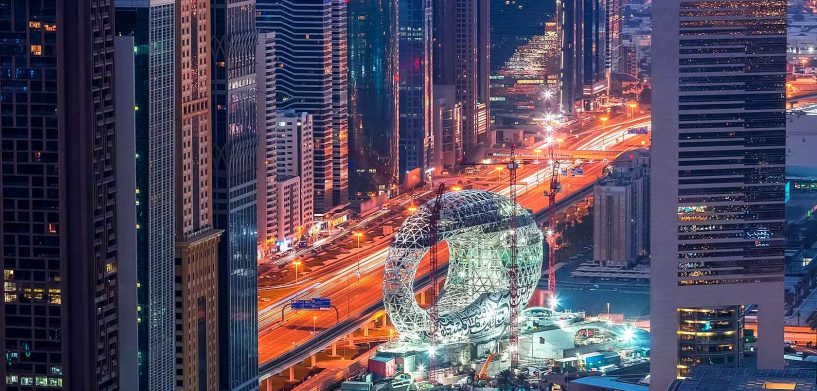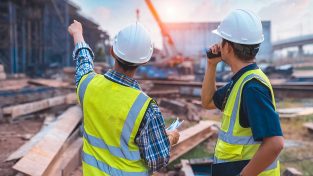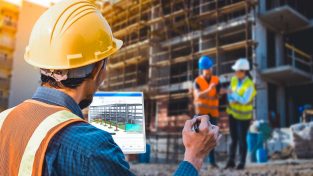Technology from Hexagon’s Leica Geosystems was instrumental in the creation of an ambitious new addition to the architectural landscape of Dubai.
Dubai is known for ambitious, visually stunning architecture, from the towering Burj Khalifa to the expansive Dubai Mall and the artificial islands of the Palm Jumeirah. But now, a new and inspiring addition to the glittering skyline of the city is taking shape in a way that brings design and technology together in a way that mirrors its mission of looking forward to the world of tomorrow: The Museum of the Future, created for the Dubai Future Foundation.
Constructed from a framework of 2,400 diagonally-intersecting beams that eliminate the need for any columns within the building’s design, the Museum of the Future is a towering 77-meter rounded silver ellipse with a void representing the unknown knowledge humanity has yet to uncover. A series of 1,024 precision-engineered composite panels skinned in stainless steel make up the curved façade of the structure, with voids in the shape of elegant Arabic script making up the building’s windows.
Realising such a unique vision was no small undertaking; every piece of the structure needed to be constructed with a high degree of accuracy, not just to match the aesthetic provided by the designers but because Dubai’s vulnerability to high winds meant crews could not risk leaving equipment hanging from cranes while modifications were made on-site. For measurements that accurate, the team at BAM International turned to reality capture technology from Leica Geosystems, part of Hexagon.
Reality capture is far more than a simple 3D scan of an object; it is a full picture of the world as it is, allowing scans to be interpreted in the context of their surroundings. Advancements in the technology by Hexagon and its partners have made capturing these robust digital information landscapes easier and more accessible than ever before and new industries are adopting its use to take advantage of the power of digital twins, or digital representations of physical objects and environments. To learn more about the developments around these burgeoning new systems, check out our blog on Myth-Busting Reality Capture: The Truth About Reality Capture Technology.
Hexagon’s reality capture systems allowed BAM to view and update the conditions in the building on-site at all stages of construction. This was paramount to the success of the complex supply chain involved, as data needed to be collected, interpreted and shared seamlessly between on-site operations and fabricators offsite. For this, the Leica ScanStation P40 was used to accomplish all of these tasks in conjunction with Leica Cyclone postprocessing office software, which exchanges information across devices during entire projects from inception to completion. These tools enabled the crews onsite to look for any discrepancies that may have occurred from the initial designs and send updates directly to fabricators so every part of the complex structure would fit without modification immediately upon its arrival.
“Brackets for more than 1,000 separate panels were put on the building by the steel subcontractor,” says BAM Digital Construction Manager Derek Bourke. “We knew they were going to fit, with no hold-up for rework or modifications required. That alone allowed us to meet project deadlines and milestones. Being able to identify problems offsite in advance of installation is a huge cost and time-saving benefit for any main contractor.”
The pinpoint accuracy provided by Leica Geosystems’ scanners created a quick and efficient production process for the state-of-the-art structure, and the museum has achieved LEED Platinum status thanks in no small part to the meticulous nature of its design. Opened on 22 February 2022 (chosen for the symmetrical significance of the date,) the Museum of the Future offers seven floors of stunning exhibition space, with three housing exhibits on outer space resource development, ecosystems and bioengineering and health and wellbeing, three highlighting near-future technology, and one floor dedicated entirely to children’s activities and learning.
The Museum of the Future itself is a statement about the future of humanity: in order to continue moving forward, we must embrace new technology and build upon its advancements in the years to come. The team responsible for constructing this modern marvel took that lesson to heart, as Eoin Ryan BIM Coordinator for the project said of the tools used in bringing it to life: “I probably won’t ever work on anything like this again, but based on my experience, it doesn’t matter what size job you have, or whether, according to the requirements, you choose a ScanStation P40, a RTC360 or a BLK360 – a 3D laser scanner gives you the results you need and I would insist on it in the future.”
You can visit The Museum of the Future’s official website here.

















